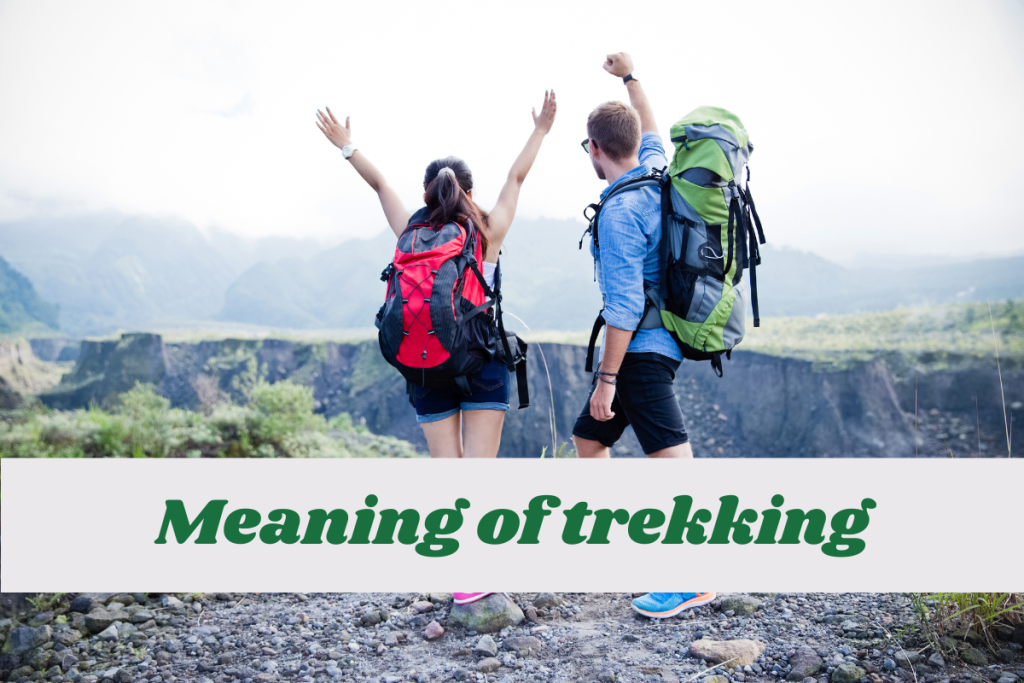When someone mentions the word trekking, they immediately visualize rugged, winding places and places of great height. Our TrekkSpot blog post takes us into the depths of defining what trekking means, its importance in current world, and how platforms such as Instagram and Google are influencing what trekking is all about and its current relevance.

Definition of Meaning of Trekking?
People use the term trekking to describe a journey of more than one day, which they make by walking, typically in a rural, mountainous, or natural area. As compared to mere hiking, trekking requires physical strength, mind power, and experience in skimming people during travel.
The word “trek” rooted in the Dutch word “trekken,” meaning to pull or travel, and its relevance seen in diverse parts of world due to exploratory and adventurous tourism. Nowadays, the term “trekking” is accepted globally in experiential traveling in which path is considered more significant than place.
Trekking is a deliberate journey to nature, in most cases to places of remoteness or even possibly hard places, and this contributes towards physical endurance and spiritual growth. It is more than a sport it is a kind of therapy, self-realization and personal development.
Major feature of trekking?
- Duration: treks are long lasting and not done in a day.
- Place: it done in forests, mountains, a desert, or an agricultural setting.
- Difficulty: In other trails, the level is easy to extreme.
- Purpose: The emphasis made on the trip, discovery, and the contact with nature.
- Vehicles: On treks, there is no use of vehicles.
Take the case of the Everest Base Camp Trek, Roopkund Trail, or Valley of Flowers Trek—it tests the body and, at the same time, provides a soul-stunning experience. Trekkers do not only bring back photographs, but most of them also have their minds changed.
Trending Platforms:
Thanks to digital transformation, the virtual space has been invaded by the definition of trekking. The social media and the search engines have made significant contributions in the way this activity is perceived and taken up by the people. Two main platforms, which rule the trek talks, are Instagram and Google.
Instagram:
Instagram has also turned into an aesthetic portal into the universe of trekking. From assorted mountaintop selfies with the sun in the background to a cinematic compilation of trail adventures, this has become a deep-seated venture into trekking on the internet.
•Travel bloggers and influencers excite their home bases with detailed tour guides, gear ideas, and behind-the-scenes footage, encouraging their followers to take up trekking as one of their activities.
•The Story Highlights can sometimes be accounts of the whole trek’s events—arrival at base camp up to the summit.
•User-generated content: gives real information and e-trail reviews, making planning of treks a more community-based aspect.
TrekkSpot emphasizes that trekkers should capture their experiences with a goal in mind—not to show only the beauty of scenery but also the true nature of treks—fatigue, camaraderie, and the fickle weather. This goes a long way towards maintaining the authenticity of the meaning of trekking as raw, authentic, and relatable.
Instagram has made trekking aspirational. However, with proper content, it makes it less difficult and instructive too. With tips on packing lightly and having risk safety reels, it serves as a linkage tool between a novice explorer and an experienced hiker.
Google:
Instagram captures the emotion, whereas Google captures the intent. When a person hears the question, What is the meaning of trekking? In Google, he/she then wants to get clarity, knowledge, and guidance.
TrekSpot has made an investment in high-quality and search engine-friendly content to make sure that trekking enthusiasts can have the right and inspiring, along with practical, information. Be it a blog about newbie walks in India or an article in which trekking is being compared to hiking, Google assists in broadening and narrowing down the meaning of trekking to every visitor.
In the process of complying with the Helpful Content guidelines of Google, TrekkSpot writers also take care and make sure our readers are informed, empowered, and ready to walk any trail.
Why the Meaning of Trekking Matters Today?
It is quite ironic to live in a time of digital excess and fast-paced living where trekking makes it possible to move back to slowness, simplicity, and connectedness. The natural idea of what trekking is all about, as it takes you out of the virtual and back to the elemental: the earth, air, water, and the breath within.
Mental and Physical Plus 4.
•Mental Sharpness: Trekking relieves stress and makes a person focused.
• It increases cardiovascular fitness: increases stamina and fitness level.
•Mindfulness: The experience in nature will lead to present-moment awareness.
•Boosts Self-Confidence: Pasture traverse builds up the mental capacity.
According to TrekkSpot getting into trekking is not only getting away, it is getting in—getting in understanding who you are, your boundaries, your fears, and what you can hope to achieve. Trekking teaches individuals to disconnect and reconnect to something more natural about life.
Final Thoughts
That brings us down to what trekking means. It does not merely mean strolling in the woods. It is a metaphor of life itself, with its twists, turns, surprises, and self-discovery. Hiking teaches you how to be patient, strong, and mindful. It tests you physically, something that also challenges your mind.
The equipment, which is never more convenient to acquire than with platforms like Instagram prompting the dreams and Google allowing making the informed choice, has never been more accessible than in the trekking world. And when you have a brand like TrekkSpot by your side, you not only walk trails, but you are also walking into a transformation tale.